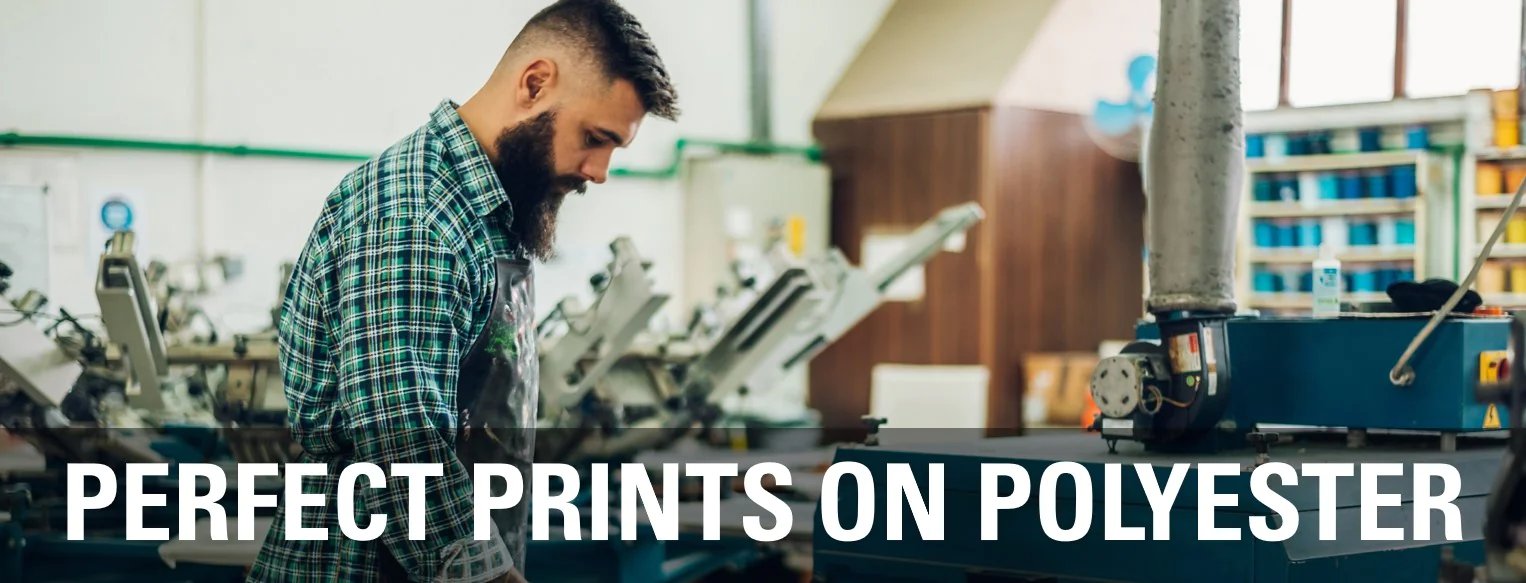

Decoration Tips
Field-tested guidance for screen printing and heat transfers on performance polyester.
Screen Prints
- Ink: Use low-bleed plastisol (often labeled “poly” or “athletic” inks) to prevent dye migration; avoid standard plastisols (non-low-bleed) unless using a blocker underbase.
- Blocking: Print a gray barrier blocker when working with dark or bright polyester colors.
- Curing: Aim for 275°–300°F (applies to low-cure inks). Verify with a heat gun or temperature probe to confirm surface cure without overheating the fabric.
- Flashing: Keep flash times short (~5–7 seconds) to gel ink without overheating. Multiple light flashes are preferable to one long, hot flash.
- Testing: Always test on the exact garment color and fabric before production.
- Storage: Store blanks in a cool and dry environment.
Heat Transfers
- Temperature: Use lower-temp transfer films whenever possible (typically 250°–310°F).
- Time & Pressure: Use the lowest pressure, temperature and time required for the transfer type to minimize value change or sheen increase on heat-pressed areas of fabric.
- Pre-Press: Do a 2–3 second pre-press to remove moisture and smooth wrinkles.
- Cover Sheet: Always place silicone, Teflon, parchment or Kraft paper between the press and transfer to prevent gloss marks or discoloration.
- Transfers: Use bleed-blocking transfers to prevent dye migration.
- Testing: Always test your transfer on the exact garment color and fabric.
Recommendations for 15 Popular Colors of 5-Star Fabric
| Fabric Color | Screen Print | Heat Transfer | |||
|---|---|---|---|---|---|
| Cure Temp | Ink | Blocker | Application Temp | Transfer Type | |
| Black | 275°–300° | Low Bleed | Barrier Gray | 250°–310° | Bleed Blocking |
| Light blue | 275°–300° | Low Bleed | Barrier Gray | 250°–310° | Bleed Blocking |
| Graphite | 275°–300° | Low Bleed | Barrier Gray | 250°–310° | Bleed Blocking |
| Forest | 275°–300° | Low Bleed | Barrier Gray | 250°–310° | Bleed Blocking |
| Gold | 275°–300° | Low Bleed | Barrier Gray | 250°–310° | Bleed Blocking |
| Maroon | 275°–300° | Low Bleed | Barrier Gray | 250°–310° | Bleed Blocking |
| Navy | 275°–300° | Low Bleed | Barrier Gray | 250°–310° | Bleed Blocking |
| Athletic Orange | 275°–300° | Low Bleed | Barrier Gray | 250°–310° | Bleed Blocking |
| Purple | 275°–300° | Low Bleed | Barrier Gray | 250°–310° | Bleed Blocking |
| Safety Yellow | 275°–300° | Low Bleed | Barrier Gray | 250°–310° | Bleed Blocking |
| Safety Orange | 275°–300° | Low Bleed | Barrier Gray | 250°–310° | Bleed Blocking |
| Scarlet | 275°–300° | Low Bleed | Barrier Gray | 250°–310° | Bleed Blocking |
| Silver | 275°–300° | Non-Low-Bleed | N/A | 250°–310° | Non-Bleed-Blocking |
| Royal | 275°–300° | Low Bleed | Barrier Gray | 250°–310° | Bleed Blocking |
| White | 275°–300° | Non-Low-Bleed | N/A | 250°–310° | Non-Bleed-Blocking |
Testing performed at Made Lab.
Disclaimer: Using low-cure ink, low-bleed ink, or barrier blocker is recommended for best results. Always consult with ink/transfer manufacturer's product/application specifications to ensure compatibility. We recommend performing in-house testing/sampling before production to verify results.


